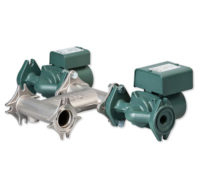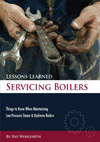These new emissions limits have prompted users to actively search for reliable and economical combustion technologies that can exceed current and future environmental performance standards. New, energy-efficient ultra-low NOx (ULN) burner technology has demonstrated reliable operation on multiple once-through steam generator (OTSG) units in the Kern County Oil fields, doing so by achieving sub-5 ppm NOx emissions at excess air levels below 10% with exceptional combustion stability.
BACKGROUND
Steam flooding is a common method of extracting heavy oil and is the main type of thermal stimulation of oil reservoirs, which are relatively shallow. The OTSGs in California operate primarily on natural gas and other gases with an energy content varying in the range from 800 to 1,200 Btu/scf. In some cases, off gases with much lower heating value content, like casing gas, are used in smaller amounts. These gases are typically available at much lower pressure than natural gas and are supplied to the burners through separate piping and fuel injectors.
Due to the high concentration of dissolved solids, steam generators for thermal enhancement of oil recovery are mostly “once-through” design. The common steam generators in California are rated to 25, 62.5, and 85 MBtuh (HHV) and typically operate at 80% to 100% of its capacity. Radiant sections in these furnaces range from 7.5 to 11 ft in diameter and 30 to 50 ft in length, with water-steam tubes along their periphery. The generators require good uniformity of the heat flux distribution over the furnace circumference. There are also limitations to the peak heat flux to the walls due to presence of deposits inside the tubes and exposure to the flame tube supports that have no cooling. The generators typically operate unattended around the clock and have to reliably adjust to any disturbances created by variable atmospheric conditions while operating within emissions limits.
DESIGN, PRINCIPLE OF
OPERATION, AND CONTROLS
Designed for the OTSG market, the patented QLN-II™ burner employs a combination of NOx reduction techniques successfully applied in several prior products: simulated lean premixing of a portion of the fuel with the combustion air, fuel staging, recirculation of combustion products within the furnace back into the flame zone, and external flue gas recirculation (FGR).
The burner consists of a large spinner supported by an air pipe in the center. A series of large air ports extend in radial directions around the central pipe, delivering a majority of the airflow. The burner is equipped with three groups of fuel injectors: simulated premix fuel injectors positioned inside the air ports, fuel injectors delivering fuel into the recirculation area in the wake of the spinner, and staged fuel injectors placed in between the air ports. The spinner position, with its fuel injectors and air ports, protrudes a few feet into the furnace. The main burner assembly is supported by the boiler front wall, with an additional support off the wind box front to compensate for the cantilevered load
During burner operation, the flame is anchored only to the spinner from which it propagates toward the downstream direction. Combustion of the premixed portion of the gas is delayed as the fuel concentration remains below the fuel lean flammability limit for a period of time. A negative pressure region at the furnace front is created by the strong aspirating effect of the air discharging from the ports and the jets of staged fuel. In a furnace with sufficient cross section, this results in a substantial portion of post flame combustion products returning back to the furnace front and then being entrained into the flame.
A single fan delivers the mixture of combustion air and flue gas. There is only one modulating fuel control valve required despite the multiple fuel injection points. The combustion air fan may be of constant speed, or have a VFD (the latter is preferred for additional energy savings). Depending on the configuration, two dampers (wind box and FGR damper) or three dampers (addition of an inlet box damper) can be utilized. Implementing three dampers allows an additional 10% to 12% of fan horsepower savings. Combustion controls may be configured with a wind box oxygen sensor or with other means of controlling the FGR flow, depending on the user preference. The low excess air level operation is maintained based on input from the stack exhaust O2 sensor.
Absence of a refractory throat eliminates the need for any refractory work during the burner installation, providing substantial cost savings. The size of the single round opening in the furnace front wall necessary to mount the burner is smaller than the typical size of a diverging tile throat of a conventional burner with comparable capacity. Specifically designed for convenience, the QLN-II™ burner is an economical solution for retrofit applications. Since there is no burner body placed inside the wind box, almost any existing wind box can be effectively reused even if the original system was designed for lower flow rates without the FGR.
PROVEN PERFORMANCE
The first QLN-II burner was commissioned in January, 2008 at the Round Mountain oil fields near Bakersfield, CA. Currently there are 10 generators operating with these burners with 98%+ utilization during the past 3.5 years. Nine generators have a rated heat capacity of 62.5 MBtuh (HHV) and one rated for 85 MBtuh. Burner controls were furnished by the customer on all units.
The smaller burners were originally set to operate with NOx emissions of less than 7 ppm with a stack O2 of 3% by volume. Routine tests of the emissions have demonstrated that the actual NOx ranges were between 5 and 6 ppm. Additional subsequent tuning of the burner controls established stable operation below 5 ppm NOx.
A recently commissioned larger 85 MBtuh unit was configured slightly differently than the smaller units. It was easily set for automatic operation with sub-5 ppm NOx emissions throughout the operating range with a maximum FGR rate of only about 28%.
The excess oxygen in the stack at loads above 50% was set at 2%. At the main load range above 50% the CO emissions were below 3 ppm and remained low with the excess O2 down to about 0.6% without any signs of combustion instabilities and with ultra-low NOx.
CONCLUSION
ULN burner performance is achieved with relatively low FGR rates. Lower FGR flow reduces the volumetric flow passing through the combustion air fan and the necessary power to move the flow through the system. The simple burner design of the QLN-II™ burner leaves the wind box essentially empty from substantial obstructions to airflow, making it easy to achieve the desired air distribution through the burner ports with minimal burner draft loss. This facilitates the ability of the burner to operate with low excess air therefore minimizing heat losses through the stack.
The burner allows substantial latitude in deviations of induced FGR and excess air rates without developing combustion instabilities. The amount of FGR necessary for NOx control is substantially lower than what is typically required by premixed ULN burners for achieving comparable emissions. This, in conjunction with low burner draft loss and low excess air capability, presents energy efficient ULN burner technology for OTSG with the lowest NOx emissions operating in the California OTSG market today. As strict air pollution regulations are creating great economic challenges to remain competitive in a fierce global environment, Coen Company continues to pursue and implement innovative technology to deliver economic and environmental combustion solutions. TB
REFERENCES
- San Joaquin Valley Air Pollution Control District Rule 4320 - Advanced Emission Reduction Options for Boilers, Steam Generators, and Process Heaters (Adopted October 16, 2008)




